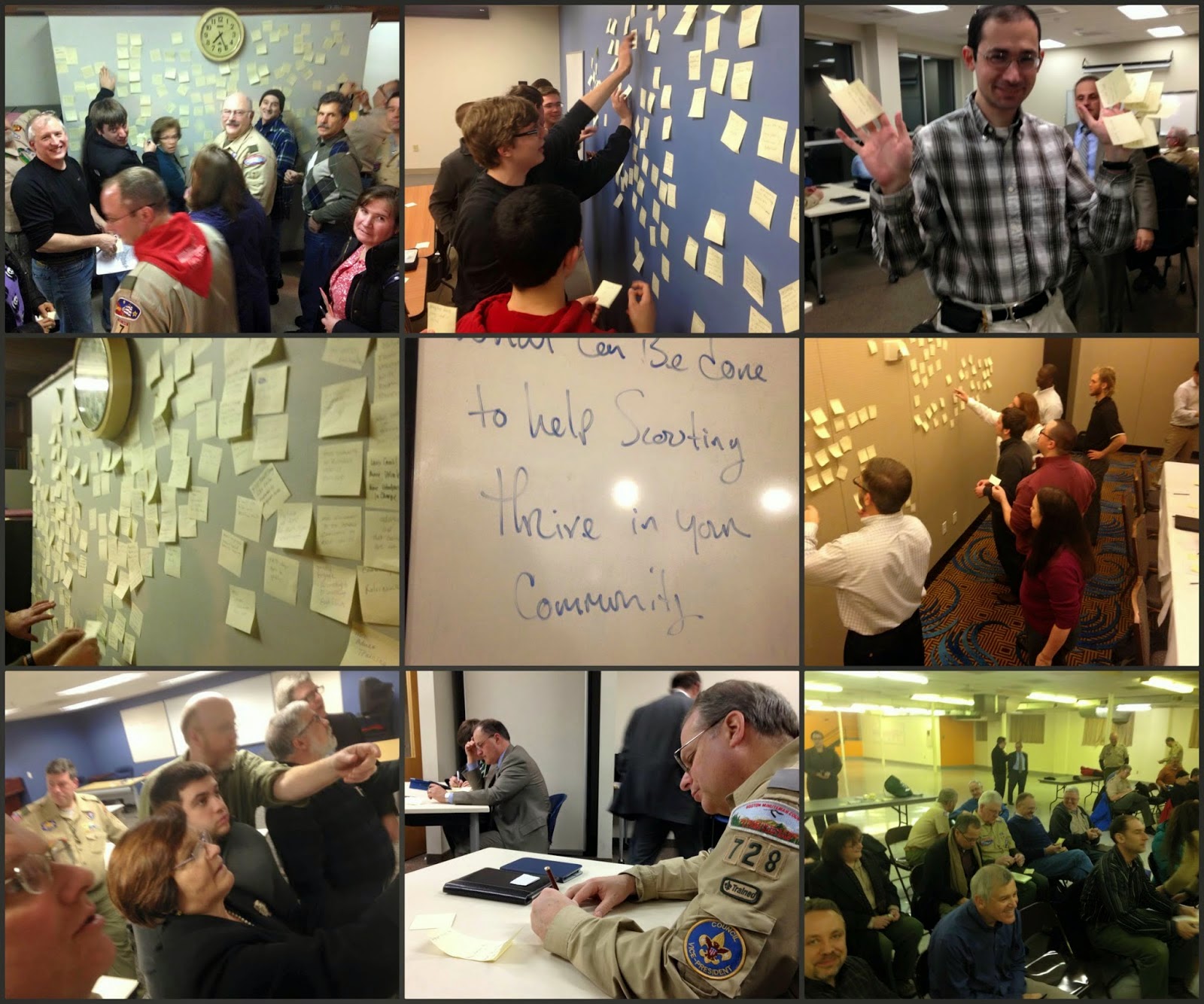Chapter One: The Listening
Sessions
What can be
done to help Scouting thrive in your community?
Throughout the
exercise we encouraged everyone "not to worry" if your idea doesn't
seem to resonate with the folks in the room, it's larger exercise and your idea
(or priority) will find it's way into "Chapter 2.
Chapter Two:
The Committee Work
An example of
how this feedback is used and where your idea goes from here
Prior to the listening sessions we took the liberty to
create seven primary committees. Those committees are called the joint
strategic committees. The categories we came up with in the listening
sessions will fall into those seven joint strategic committees. (check out
the collaborative
web page for additional details) As an example during several
sessions the category of "online," or "technology" or
"systems" were created. The folks who attended those
sessions believed technology and internal communication solutions would
"help Scouting thrive in our communities." We have reviewed every
single post it note and created a sub category under customer service. It
falls under customer service because the majority of the
"Technology" post it notes have a customer service component to
them.
The Systems subcommittee
will receive all those post-it notes as well as the annual costs from both
councils for technology, and any post camp and/or post program evaluations that
mention technology. They will also be encouraged to do research into
alternative software solutions.
Online /
Technology / Systems envelope with post it notes highlighted
The natural outcome of all this categorizing and
prioritizing is discovering an ultimate a "winner." As if by
focusing on the ultimate winner we could solve all Scouting's issues. But
common sense (and all the dialogue throughout every session) showcases that
looking for the one solution, won't really solve anything. Because all these
items are so interconnected. If we could wave a magic wand and tomorrow solve
all our customer service problems would Scouting then thrive in all our
communities? Of course NOT. Without the adequate funding wouldn't those
customer service solutions be short lived? How can we say we solve customer
service problems if our facilities are falling apart? If we don't solve our
governance short comings won't we just make the same mistakes
again?
It's clear that each category is directly connected to each other category. That's why our collective strategy is so critical to this process.
How we build our collective strategy
We'll stay with systems and customer service as our running example. Customer service turned out to be the second highest priority. (a close second to youth experience / program) Admittedly, it's a pretty broad category and there are a lot of ways to fix and improve our customer service. However, customer service through technology is clearly important one. So, in April the systems committee will propose recommendations in coordination with the joint customer service committee to the merger oversight committee.Those solutions will likely impact other aspects of the plan, cost of technology, expertise, hardware upgrades, marketing etc. The Merger oversight committee will work with all related committees to reconcile proposals and draft the final plan.
It's clear that each category is directly connected to each other category. That's why our collective strategy is so critical to this process.
How we build our collective strategy
We'll stay with systems and customer service as our running example. Customer service turned out to be the second highest priority. (a close second to youth experience / program) Admittedly, it's a pretty broad category and there are a lot of ways to fix and improve our customer service. However, customer service through technology is clearly important one. So, in April the systems committee will propose recommendations in coordination with the joint customer service committee to the merger oversight committee.Those solutions will likely impact other aspects of the plan, cost of technology, expertise, hardware upgrades, marketing etc. The Merger oversight committee will work with all related committees to reconcile proposals and draft the final plan.
In early May those recommendations
will come back to the Scouting community through a series of open forum
meetings. During that time the proposed answers will be placed in a timeline.
The timeline will allow for all or most ideas to be realized, the only variable
is when.
Chapter Three: The Collective
Plan to help Scouting thrive.
Final adjustments may be made at
that time, and in June the entire Scouting community will be our collective
aware of how we choose to answer the question "What can be done to help
Scouting thrive in your community?"
How you can help
Click here and Enter you name, e-mail and choose which
committee you interests you. Each co-chair and sub committee will
need participants. We are going to keep all committees to about 8 (a patrol
and manageable size). The committee chairs will be looking for people
with specific skills for certain committee - to stick with our example - a few
IT and web based professionals will be needed for the Systems Committee. If
your first choice committee is full, you'll be free to contact others and the
committees will work together to take you up on your willingness to help.
Lastly, this process is designed to give voice to as many volunteers as
possible. the Joint Committee Chairs will discourage any one Scouter from
serving on multiple committees.


No comments:
Post a Comment